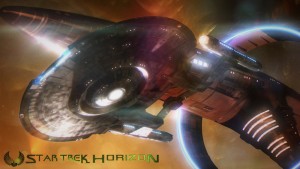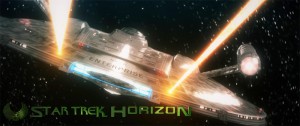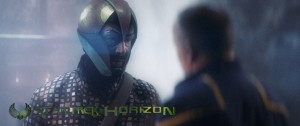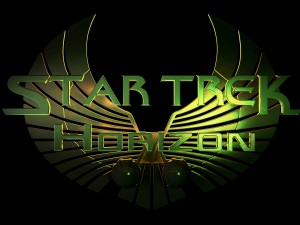 Man, are you guys ever in for a treat! The full-length Star Trek: Horizon has just been released to the general public, and it is a cinematic triumph of Trek fan films.
Man, are you guys ever in for a treat! The full-length Star Trek: Horizon has just been released to the general public, and it is a cinematic triumph of Trek fan films.
Show-runner Tommy Kraft gave me a special link to view the movie early. I’d watched barely the first 15 minutes when I shot him a Facebook IM saying simply “F—king WOW!”
Horizon (no ‘s’ at the end, folks!) starts out with a bang—several, in fact—and immediately lets the viewers know that they’re in for a wild and high-quality fan film ride. I’ll try to keep spoilers to a minimum, but if you want no spoilers at all, skip down a few paragraphs to the END OF SPOILERS line and then read on after that. Otherwise, consider yourself warned…
OFFICIAL SPOILER WARNING!
Unlike many other Star Trek series (both studio-produced and fan-made), the Horizon in the title does NOT refer to the name of a starship. Instead, it is the name of a planet with a devastating weapon that was created 250,000 years ago by the Arioui (an original race) to destroy the Iconian Great Alliance. The Iconians were a race that was originally introduced in the season two Next Generation episode “Contagion.” Fans have since been intrigued with the Iconians, and they’ve appeared in multiple novels, short stories, and even the Star Trek Online video game.
Star Trek: Horizon takes its place as one of the very few fan films set during the time of the series Star Trek: Enterprise, specifically in 2160, one year before the end of the Romulan War and the formation of the United Federation of Planets. So the war is very salient in the story, and scrimmages with the Romulans play a major part in this movie.
Although we do see the Enterprise NX-01 in this film, the “star of the show” is the NX-04 Discovery, captained by Harrison Hawke, a much more military-style commander than Jonathan Archer. One might assume (although it is not specifically stated in the film) that after hostilities broke out with the Romulans, Starfleet shifted its priorities in assigning captains to the NX fleet from seeking those who were explorers to favoring ones with more tactical military training.
All of the actors cast were experienced professionals with IMDb pages rather than simply grabbed from a pool of untrained fans, and they give consistently impressive and believable performances. I realize that not every fan film has access to “real” actors, but it’s amazing what a difference it can make.
The look of the film is amazing, and the uniforms are spot on to the original 22nd century jumpsuits seen on Star Trek: Enterprise…and I mean spot on! The visual effects are also spectacular, and not just the starship exteriors and space battles but also some meticulously modeled background interiors of the NX starship, which are composited in behind actors who were filmed in front of green screens.
And while many fan films, out of necessity, use music taken directly from Star Trek or other sources, Horizon features an entirely original score that sounds like someone kidnapped Bear McCreary (from the new Battlestar Galactica) and had him compose new music for a Star Trek fan film.
And speaking of Battlestar Galactica, Horizon has a very similar directorial feel using a shaky camera technique and often out-of-focus backgrounds with dreamlike lighting and (gasp!) lens flares. It’s a very unique and fresh approach for Star Trek…especially for a fan film. While I’m sure some fans won’t like it simply because it’s so different from the more familiar style we’re used to, I favor the bold approach. If every artist painted a bowl of fruit that exact same way, we’d never have true art.
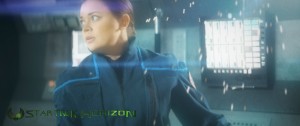 And speaking of artists, all of the above—except for the acting—was accomplished primarily by one person, a young filmmaker from Jackson, Michigan recently graduated from music school: Tommy Kraft. Although there are dozens and dozens of other names listed in the credits, here’s what it says above Tommy’s name:
And speaking of artists, all of the above—except for the acting—was accomplished primarily by one person, a young filmmaker from Jackson, Michigan recently graduated from music school: Tommy Kraft. Although there are dozens and dozens of other names listed in the credits, here’s what it says above Tommy’s name:
“Written, Directed, Edited by, Music By, Visual Effects By, and Director of Photography and Costume Design By…”
If ever there were a “Renaissance Man” of Star Trek fan films, it would be Tommy Kraft. And after a three-year odyssey that included countless hours of non-stop work and dedication, Tommy finally debuted his completed 102-minute masterpiece yesterday to the delight of fans who had been eagerly awaiting this film since late 2014 when Kraft posted his first trailer. Since then, the trailer has logged more than 3.25 million views on YouTube.
I caught up to this fan film dynamo, and he was gracious enough to provide a very insightful look into the origins and evolution of this production that moved almost immediately onto my list of MUST SEE Star Trek fan films. Ladies and gentlemen, a round of applause for Tommy Kraft…
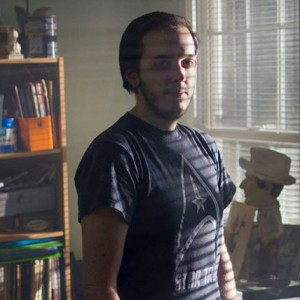
JONATHAN: Dude, you and your team have knocked this one out of the park! My sincere congratulations on a job masterfully done…
TOMMY: First of all, thank you again for all the nice things you said. I’m really, really glad you liked the movie so much. That’s very encouraging to hear!
JONATHAN: So let me start by asking the most obvious question: why Enterprise-era? Most fan films avoid 22nd century stories because the costumes and sets are so challenging to make (versus 23rd or 24th century Trek). And to be honest, the last TV series wasn’t all that popular or successful. So why aim your first major fan film effort in that direction?
TOMMY: I’ve had numerous ideas for fan films over the years. I always thought it’d be fun to do a Deep Space Nine fan film, and as a huge fan of Stargate, I’ve always had ideas for stories in that universe. When it comes to difficulty, honestly, all of these are about the same. You still find yourself in the position of having to create costumes, sets (virtual or physical), ships, etc. So, it’s really a matter of which one is most important to you. Enterprise was personally very important to me. That’s why I chose that series to pursue. It helped me through a very rough time and inspired me in a way no other Star Trek show did.
JONATHAN: If I may ask, how did Enterprise help you personally?
TOMMY: My depression started in 2012, not long before I began working on Horizon. Enterprise, the character of Captain Archer, and working on the film served as huge inspirations and passions for me that helped guide me through that initial episode and find some ways to cope. There was also this huge religious de-conversion to atheism involved that was one of the best things that ever happened to me. Captain Archer, always being the explorer, inspired me to explore beyond my fundamentalist Christian upbringing, and what I found—basically, science; I found I have a huge passion for it—changed my life for the better in a lot of ways.
JONATHAN: Wow, I never imagined that Enterprise could be so inspiring. But if Captain Archer could help in your struggle against depression, then I’d say the series was a HUGE success after all!
Okay, before we dive into the Horizon itself, I’d like to ask you a little about getting from there to here. I’ve heard that you were a music major in college, but you really wanted to direct?
TOMMY: While film school would have been my first choice, I got free college tuition because my mom worked at the college I went to. Music is another huge passion of mine, so it worked out. These days I’m doing freelance film work full time. Sometimes it’s shooting commercials, and other times it’s visual effects on indie movies and commercials.
JONATHAN: I know you did some of the compositing for Prelude to Axanar. Have you worked on any other fan films…Trek or otherwise?
TOMMY: I think I did almost all of their compositing, if memory serves! I haven’t worked on any others since then though. I’ve been too busy with Horizon and my other indie film work to devote the amount of time and attention required to work on other fan projects.
JONATHAN: Why did you decide to undertake such a significant project (a full-length feature) as your first attempt at both writing and directing? Wouldn’t it have been easier to start out with a shorter film?
TOMMY: It actually wasn’t my first attempt at directing. I’ve written and directed numerous short films before Horizon and was planning to make my first feature at some point. As crazy as it was to do a scifi epic for my first feature, when I got the inspiration for Horizon, I knew it had to be the one.
JONATHAN: Which came first? Did you decide it would be an Enterprise-era adventure and then write the story or did you come up with a story first and then figure out a way to fit it into the 22nd century?
TOMMY: I always knew it would be an Enterprise story first. Enterprise being such a huge inspiration for me, it was my goal to close out story threads left hanging when they were canceled.
JONATHAN: How long did it take you to develop your script? Did you just pop it out like a Tic Tac, or did you do lots of revisions and rewrites?
TOMMY: It took me probably between 3-6 months from the first ideas to the final draft of the script. While I was supposed to be taking notes in my classes (I did take some!) I was scripting movies and writing outlines for stories. I wrote about half of the film’s outline and then began work on the screenplay. I tend to let my first draft of the screenplay be my guide and outline; it gives me a better sense of the characters and story. From there I did fixes and redrafts.
JONATHAN: So you had your script, what came next?
TOMMY: While I was writing the screenplay, I began creating the 3D models. It was a hand-in-hand process. Some days I’d work more heavily on the script, other days I’d work more heavily on the models. The virtual bridge set was the first model I began work on, and then I began with the ship itself and other interiors for the ship including Engineering, corridors, etc. I did all of my 3D modeling in Autodesk 3DS Max 2012 and texturing of those models in Adobe Photoshop
JONATHAN: Speaking of virtual sets, many fan films have shot actors in front of green screens, and then later they composite 3D backgrounds behind those actors. And usually when these scenes happen, the camera doesn’t move and neither does the background image. But the first eye-catching scene that we view in your first trailer shows a Romulan with both the camera and background spinning around him. How did you manage that?
TOMMY: That particular scene was accomplished with a swiveling office chair, and that’s it! I basically had the actor (Ryan T. Husk) sit in the chair and had another person sit on the floor and slowly spin the chair while he was delivering his lines. In postproduction, you remove the green screen and add in your virtual bridge set, with a virtual camera that rotates in a circle in the opposite direction your actor was rotating. When you drop in your footage it looks as if the scene was shot with a camera rotating around the actor. Other scenes with camera motion were largely created by filming on a tripod without moving the camera, and then dropping that 2D “plate” into a scene with a camera doing things such as dollying in or out. And just to note, we didn’t have anything fancy for this stuff, it was shot almost entirely in front of a home green screen in my parents’ basement.

JONATHAN: So you filmed this entire movie in your parents’ basement? You must have VERY supportive parents!
TOMMY: I do have very supportive parents, and I can’t thank them enough for that. I’ve seen a lot of parents who—when their kids wish to pursue the arts—immediately shut them down and demand that they get a “real” job in the medical or business field. My parents never did that. They always supported my creative ambitions and pushed me to always pursue my dreams and goals. In fact, my mom even taught me how to sew when I started Horizon so I could create all the costumes for the film.
JONATHAN: Well, I have to admit that those uniforms look amazing! Did you also design the patches for the NX-04 Discovery, too? And was it you who came up with the motto PER ASPERA AD ASRTRA (“Through hardships to the stars”)? It’s eerily appropriate to Earth’s struggle with the Romulans.
TOMMY: I did design the patches! That was great fun, but if I recall correctly, the motto is one that was used for one of the patches on the show, or perhaps it was a Latin phrase I found online in one of those websites that gives you popular phrases in other languages. I can’t quite recall at this point, to be honest!
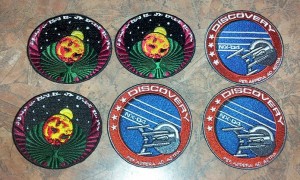 JONATHAN: Speaking of the NX-04, we know from the TV series that the first NX starship was Enterprise and the second was Columbia. If NX-04 is Discovery, then does that mean that NX-03 was Challenger, NX-05 was Atlantis, and NX-06 was Endeavour…the same order as the American space shuttle orbiters were named?
JONATHAN: Speaking of the NX-04, we know from the TV series that the first NX starship was Enterprise and the second was Columbia. If NX-04 is Discovery, then does that mean that NX-03 was Challenger, NX-05 was Atlantis, and NX-06 was Endeavour…the same order as the American space shuttle orbiters were named?
TOMMY: Sure! Why not? It’s never mentioned in the film what the names of those ships would be, but I did name the Discovery after the space shuttle, so it seems appropriate to continue on that train of thought.
Next time, we conclude our awesome interview with Tommy Kraft as we find out more about the actors and production crew, ask about his Kickstarter campaign, and take a look into Tommy’s stylistic choices as a director to make this project look unlike any fan film that’s come before.
In the meantime, I strongly recommend you make yourself some popcorn, get comfortable, turn up the volume on your speakers, and…
Watch Star Trek: Horizon by clicking here.

